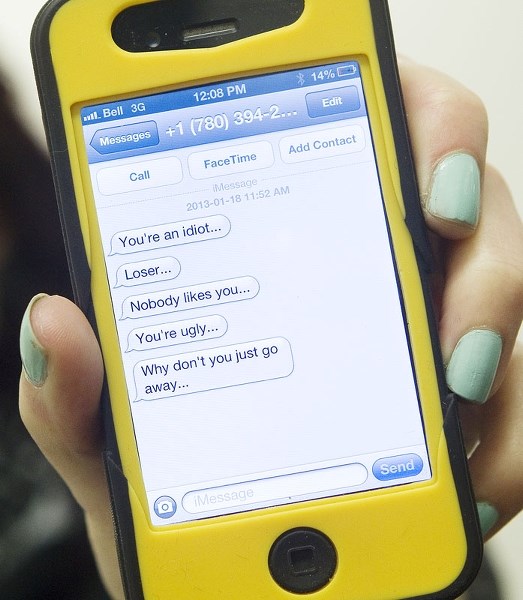With the rise in popularity of mobile devices and social media, local school boards are cracking down on the increased misuse and abuse of technology.
With the rise in popularity of mobile devices and social media, local school boards are cracking down on the increased misuse and abuse of technology.
Posting offensive or threatening language and sharing inappropriate images online or through text messages aren’t rampant in local schools, though administrators acknowledge they are a concern.
“I think that kids are so much more well versed in technology, (more) than they were even last year,” said Krimsen Sumners, associate superintendent of program and planning for St. Albert Public Schools. “This is an ongoing concern and is addressed throughout the district on an ongoing basis.”
Education is a key component in prevention and is a major focus for local school boards.
“There is a dark side to the frontier and we need to manage that as best we can and we need to keep our education program in place so it brings awareness to students about that dark side,” said Greater St. Albert Catholic Schools supt. David Keohane.
He said while technology can have a negative impact if used inappropriately, it can have a profoundly positive impact on learning when used correctly.
Students and parents within St. Albert Public Schools and Greater St. Albert Catholic Schools are required to sign a technology-use agreement at the beginning of each school year.
This agreement outlines appropriate and prohibited uses of technology and suggests consequences for students found violating the provisions, which can include confiscated devices, suspensions or expulsions.
Wolfgang Jeske, director of curriculum and instruction with the Sturgeon School Division, said students are expected to abide by a student code of conduct, which addresses appropriate technology use, but are not required to sign it. He said he is not aware of any incidents of technology misuse handled by the division.
Keohane said serious incidents of technology misuse are rare in the division of 6,200 students, adding only one incident was dealt with on the district level last year. A student was suspended for five days and received restricted technology access.
Sumners said she is not aware of any incidents being dealt with by the district this academic year, but said that doesn’t mean they aren’t occurring. Roughly 6,600 students are enrolled with St. Albert Public Schools.
“Our schools are very conscious of technology and the bullying and all the sexting and stuff that may be going on,” she said. “Those sorts of things may be handled at each individual school.”
When administrators receive reports of technology misuse or bullying online, they are expected to intervene immediately.
In extreme circumstances, school boards would turn to local law enforcement for further intervention.
“If we sense that an offence falls into that parameter of harassment or distribution of child pornography, then we would be contacting legal authorities simultaneous to … the disciplinary interventions that we would be doing at the school,” Keohane said.
RCMP involvement
St. Albert RCMP Cpl. Laurel Kading said the local detachment deals with a significant amount of technology abuse, adding the problem isn’t isolated to St. Albert or to youth.
“Every piece of technology we get, we find that we have to again educate people how to use it appropriately,” she said.
She said RCMP is involved in both the prevention and prosecution of technology misuse amongst students and adults.
School resource officers discuss technology usage regularly with students and sometimes get involved if an offence warrants criminal charges. For example, posting or sharing inappropriate photos of a minor – regardless of the age of the individual sharing it – could result in charges of distributing child pornography.
Students are advised to consult parents and school administration. Kading said if they are unsure if the offence is criminal, law enforcement could provide guidance.
“We certainly can always take a look at what is concerning them and give them advice as to whether that is a matter that the police can act on or not, and go from there,” she said.
Alberta’s newly passed Education Act requires students and schools to implement policies aimed at decreasing bullying.
The legislation, passed last November, requires students to refrain from and report bullying and requires school boards to implement policies addressing bullying “whether or not it occurs within the school building, during the school day or by electronic means.”
Keohane said he expects this legislation to be fully implemented across the province in a few years, as existing regulations and policies need to be updated.
